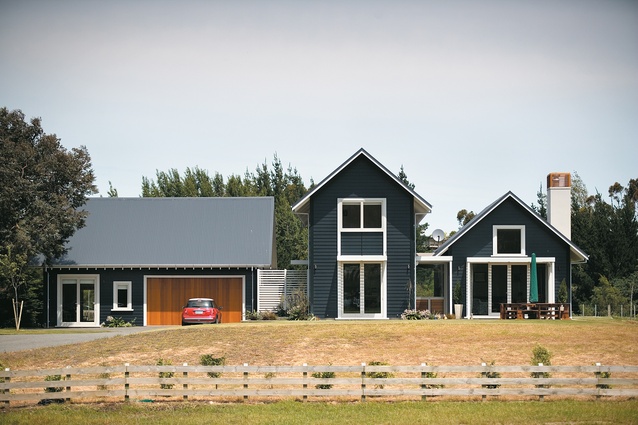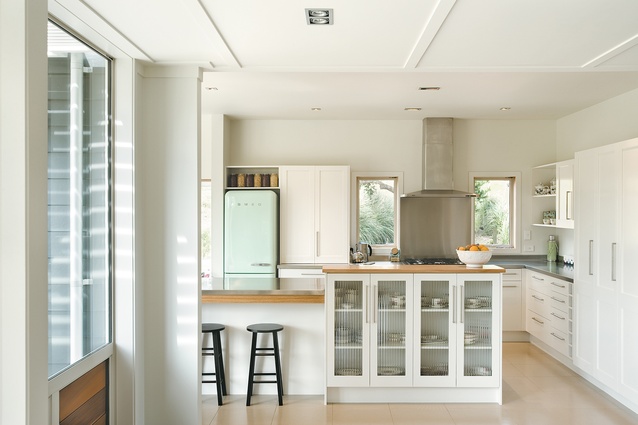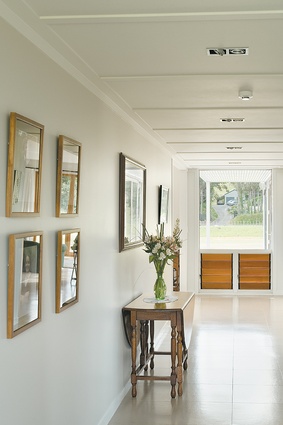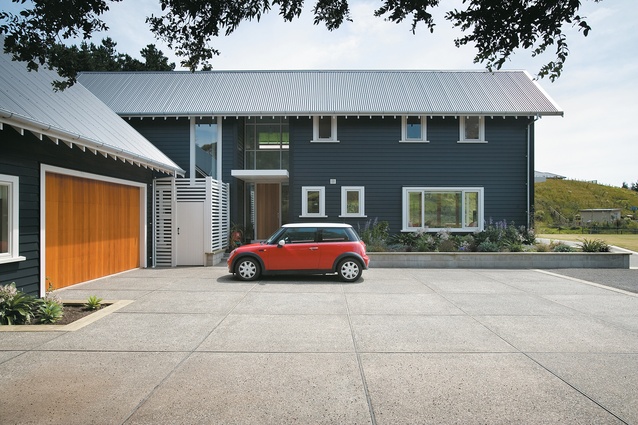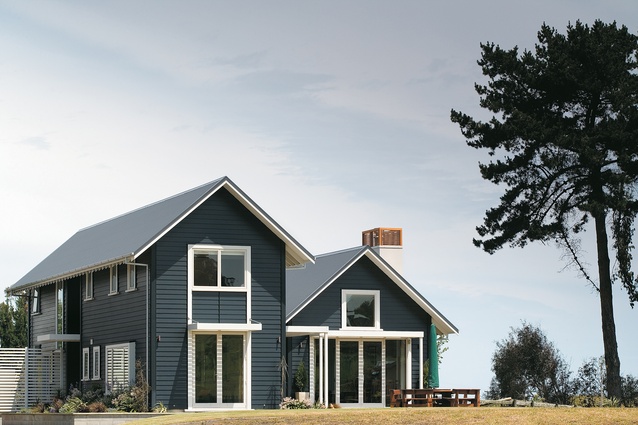Houses Revisited: Back to black
Look back at this house from our 2007 archives: In Wanganui, Dalgleish Architects look beyond precedent to design a ‘new traditional home’.
Sue van Dalen didn’t really want to move from the arts and crafts bungalow her children had grown up in on established St John’s Hill, Wanganui. It was home. She was persuaded to move by her husband John’s desire for a more contemporary home, the promise of a special site and of working with a local craftsman builder, Bayden Brown. To this mix was added what turned out to be an inspired choice: local architect Craig Dalgleish.
So the beginning point for the project was a desire for a ‘new traditional home’. This was fleshed out with a briefing scrapbook containing many images – from bungalows, boathouses, barns and coastal housing to contemporary homes, the clients’ precedents were diverse. The house had to be immediately identifiable as ‘home’. No flat roofs were required.
When she was growing up in Christchurch Ms van Dalen had been fascinated by a black house, the Guthrie brothers’ Californian bungalow ‘Los Angeles’ at 110 Fendalton Road. Wanganui has its own history of black houses, including the 1951 Vernon Brown Harper house at 151 Great North Road. The idea of a New Zealand black house tradition took root and became the architect’s point of departure. Craig Dalgliesh embraced the messy reality of the many different influences and sources and somehow cut through them to distil a house of simplicity, clarity and comfort.
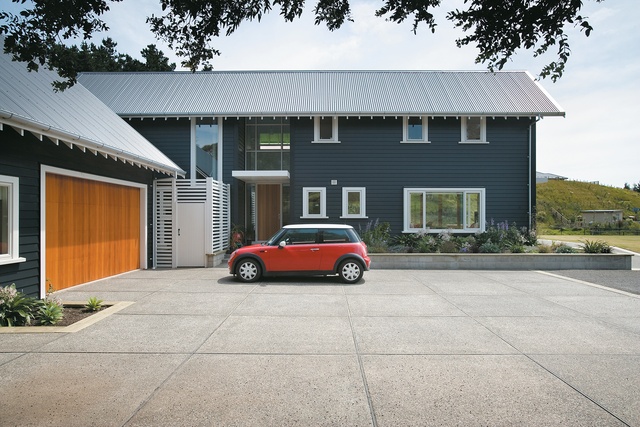
The house sits on a bend in a gully. Its site is formed as two terraces, a lower tennis court and a large house site, complete with a generous front lawn gently rolling down towards the initial approach from the north. Formally the house is three gabled rectangles. Two parallel linear gable structures, one two storey and a wider single-storey wing, are separated by an almost flat low roof section between. A separate visitors’ bedsit flat, sleeping loft and garage form the third gable at right angles to the main house to complete the ensemble.
The house is carefully composed. Its siting controls the approach to the house and views from the interior; its windows play carefully with the view and with being viewed as part of a composition. High doors reduce apparent scale. The garage gable’s orientation and its level – it is set lower than the main house – reduce its apparent bulk. The interior experience has a similar careful composition. Visual depth is created with a series of layered views through spaces to the exterior. This treatment continues with formally structured landscaping and suspended slatted screens creating a series of small landscape spaces that also extend the internal vistas.
Initial entry is through a vehicle courtyard. Large format, exposed aggregate concrete slabs and inset timber strips create a simple ordered landscape space. White horizontal slat screen walls and a somewhat incongruous solid service gate greet you as you arrive. You then rise up into the main house entry level through a raised garden below an elegant floating timber screen. Entry is generous and open to the full height of the two-storey volume above. The entry opens directly into a wide low gallery space that runs the whole length of the house linking the public spaces in the northeast to the service spaces and main bedroom areas on the southwest. From the gallery, you move off axis to the right past a country kitchen and into the family room.
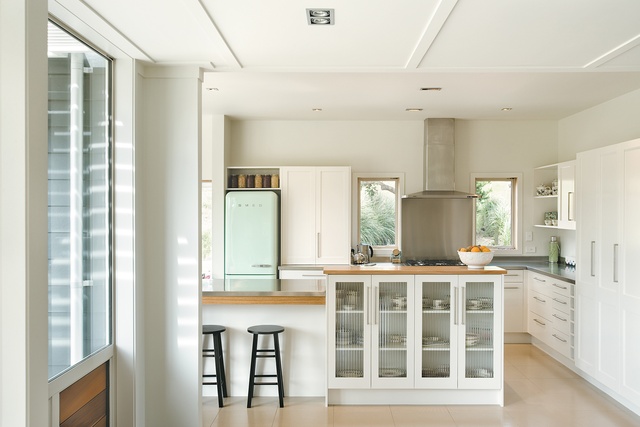
This room has views to the northwest across a concrete living court to a big lawn. There is more to the simple flat ceiling volume of the family room than is initially apparent. A window seat, a deep revealed window, the asymmetry of the courtyard doors, and the off-centre location of the end of the kitchen bench together create an unexpected spatial subtlety.
To the left is the expansive volume of the lounge and formal dining room. In this space tradition is simply expressed in the details. Painted bungalow detailing and fireplace details here sit comfortably with grooved ply doors and coffered panelled ceilings. A large square high window to the gable end frames the sky. The lounge shares the living courtyard and big front lawn. The master bedroom space at the other end of the gallery has a similar volume and window to the sky, and a special rural view.
The house planning is, in many ways, familiar. Like a traditional farmhouse the house has a single house bathroom downstairs and generous laundry and storage. Upstairs it has a long low attic-like corridor serving bedrooms that share a common bathroom off a corridor. All rooms have low side walls and coffered ceilings that extend up into the roof volume. Everything is painted one tone of near-white.
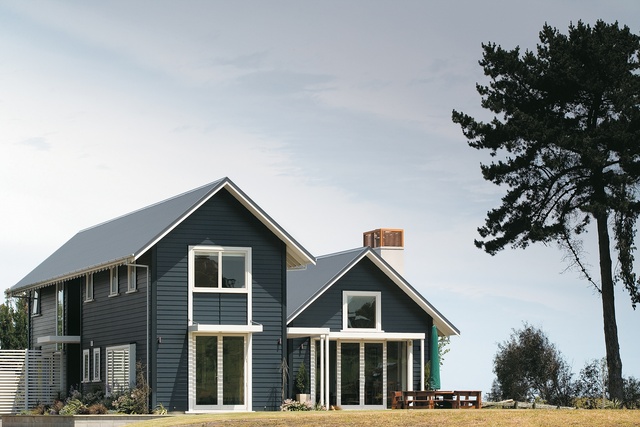
The garage and guest suite is straightforward, yet well crafted and somehow essential, completing the vehicle courtyard. Almost unnoticed are the well-built, simple vernacular carpentry construction details, such as the white window and door frames which contrast with the black Lineaboard cladding. Exposed rafter ends are expressed below the soffits. Another tradition is referenced here: a New Zealand timber-framed construction carpentry tradition.
Nostalgic architectural briefs like the one for this house are difficult for some architects. Apparently backward-looking, they come with contradictions inherent in their frame of reference. The architect might secretly grumble under his or her breath, wishing for more design room to move in. Dalgleish Architects didn’t grumble; rather, they embraced the brief and extended it in a creative partnership with the client.
In this house the idea of architectural tradition has been pushed and tested, understood, reinterpreted and extended. Lessons have been learnt and applied. Tradition here has included a wider New Zealand housing history and vernacular, alongside Wanganui modernist and more recent architectural influences. The resulting house is somehow strangely familiar and yet not. It is the ‘new traditional home’ the clients sought, yet it is also an architecture of this place and time, a fresh hybrid rooted in the architectural traditions of Aotearoa New Zealand.
Click here to see more Houses Revisited. And sign up to our email newsletters to receive Houses Revisited straight to your inbox.
Note: These are stories from our archives and, since the time of writing, some details may have changed including names, personnel of specific firms, registration status, etc.

